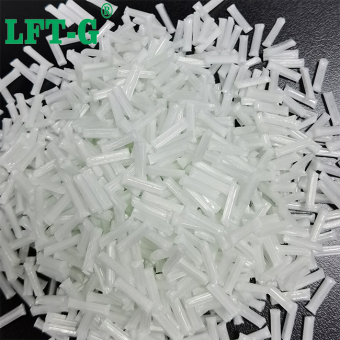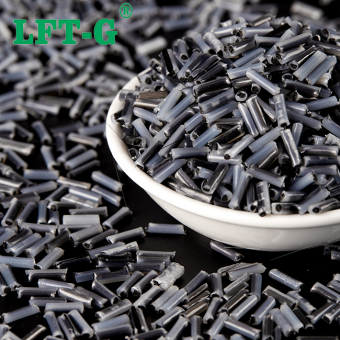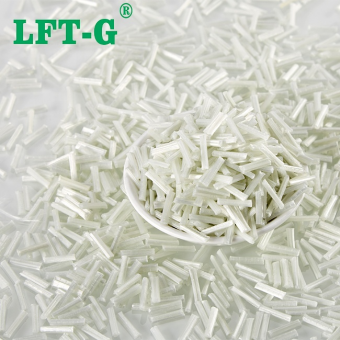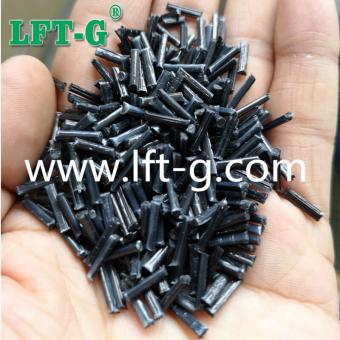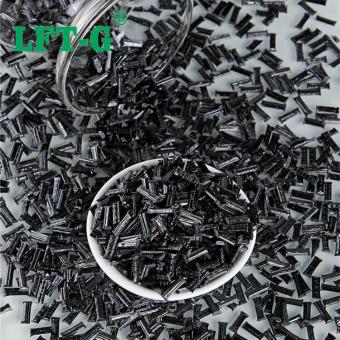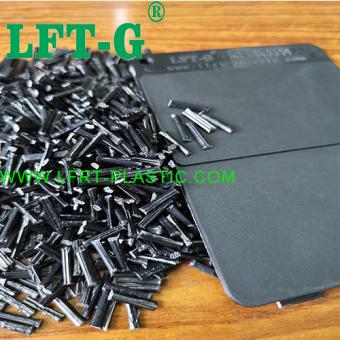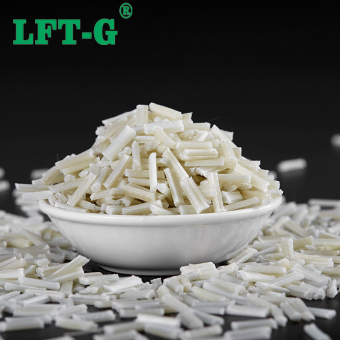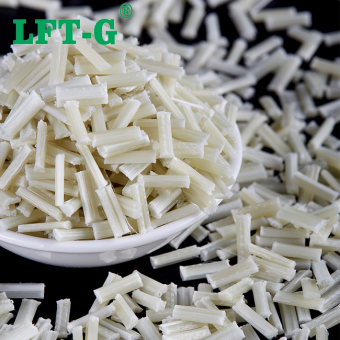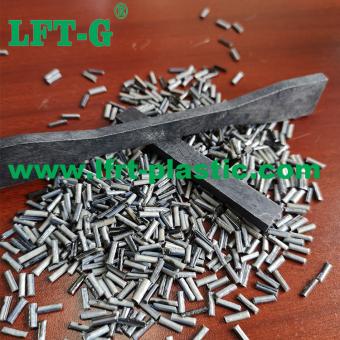-
Matéria-prima composta de fibra de vidro longa de polipropileno 40Introdução do produto O material de polipropileno reforçado com fibra de vidro longa (PP-LGF) tem sido amplamente utilizado na indústria automobilística por causa de suas vantagens de peso leve, alta resistência específica, boa resistência ao calor e reciclagem, etc. Material de polipropileno reforçado com fibra de vidro longa (PP-LGF) tem baixo custo, alta resistência específica e alta resistência ao calor e assim por diante. Desde que foi desenvolvido no início dos anos 1980, a esperança é substituir alguns metais ou plásticos de engenharia em peças de automóveis. Fibra de vidro longa de polipropileno40
- enchimento de fibra de vidro
- custo efetivamente reduzir
- em vez de medalha
- excelente resistência à fluência e à fadiga
- baixo empenamento
- cor personalizada
Tags :
-
PA6 Poliamida 6 fiiling Longo composto de fibra de carbono matéria-prima industrial lcf40Número do produto: PA6-NA-LCF40 Fibra do produto: 20%-60% Aplicação do produto: Adequado para fabricação de capacetes, solavancos de carros e robótica e braços etc. Característica do produto: alta tenacidade, peso leve, alta resistência, resistência ao desgaste, resistência à corrosão, resistência à fluência, condução, transferência de calor.
- Cor preta
- Transferência de calor
- Amostra disponível
- Produtos customizados
- Uso de fabricação
- Em vez de medalha
Tags :
-
Enchimento de grau de injeção LFT-G TPU LGF de fibra de vidro longa para ferramentas elétricasNúmero do produto: TPU-NA-LGF Enchimento de fibra: 20% ~ 60% Característica do produto: alta tenacidade, alta rigidez, baixa absorção de água, alta estabilidade dimensional, resistência química, boa aparência do produto Aplicação do produto: Portas e janelas do carro, Safty toe, Peças mecânicas, Caixas de pistola de pregos pneumáticas, Ferramentas elétricas profissionais, Porcas e parafusos, etc.
- Boa aparência do produto
- Resistência química
- cor original
- Portas e janelas do carro
- fibra de vidro longa
Tags :
-
Resistência a altas temperaturas PA12 longa resina composta de fibra de carbono peças esportivas automotivasEspecificação de fibra: 20%-60% Grau do produto: Grau NarmalVeja mais
-
Materiais de alto valor PEEK fill lcf amostra composta reforçada com carbono disponívelComo um tipo de plástico de engenharia especial, o PEEK tem excelente desempenho abrangente.
- poli-éter-éter-cetona
- PEEK composto
- Material de alta resistência ao impacto
- plástico de enchimento de carbono longo
- produtos fabricados na china
- Em vez de medalha de plástico
Tags :
-
Materiais compostos de fibra de carbono longo PA66 de alto desempenho de nylon 66 para campos aeroespaciaisWhat is PA66 plastic? Polyadipyladipylenediamine, commonly known as nylon -66, is a thermoplastic resin, generally made from adiponic acid and hexadipamine condensation. Insoluble in general solvents, only soluble in m-cresol, etc. High mechanical strength and hardness, rigidity. It can be used as engineering plastics, mechanical accessories such as gears, lubricating bearings, instead of non-ferrous metal materials to make machine shells, automotive engine blades, and can also be used to make synthetic fibers. PA66 plastic raw material is translucent or opaque opalescent crystalline polymer, with plasticity. Density 1.15g/cm3. Melting point 252℃. Embrittlement temperature -30℃. Thermal decomposition temperature is greater than 350℃. Continuous heat resistance 80-120℃, balanced water absorption rate of 2.5%. Resistant to acid, alkali, most aqueous inorganic salts, alkyl halides, hydrocarbons, esters, ketones and other corrosion, but easy to phenol, formic acid and other polar solvents. It has excellent wear resistance, self lubricity and high mechanical strength. But the water absorption is larger, so the dimensional stability is poor. What is Long Carbon Fiber? In the modified engineering plastics industry, long fiber reinforced composite material refers to long carbon fiber, long glass fiber, aramid fiber or basalt fiber and polymer matrix, through a series of special modification methods to produce composite materials. The biggest characteristic of long fiber composites is that they have superior properties that the original materials do not have. If they are classified according to the length of the added reinforcement materials, they can be divided into long fiber, short fiber and continuous fiber composites. As mentioned in the beginning, long carbon fiber composite material is a kind of long fiber reinforced composite material, which is a new fiber material with high strength and high modulus fiber. LCF carbon fiber composite exhibits high strength along the fiber axis, and has the characteristics of high strength and light weight. It has the comprehensive mechanical properties such as density, specific strength and specific modulus that are incomparable to other materials. It is a new material with excellent mechanical properties and many special functions. What are the properties of Long Carbon fiber? Corrosion resistance: LCF carbon fiber composite material has good corrosion resistance, can adapt to harsh working environment; Uv resistance: strong ability to resist UV, products by UV damage problem is small; Wear resistance and impact resistance: compared with the general material advantage is more obvious; Low density: lower than the density of many metal materials, can achieve the purpose of lightweight; Other properties: such as reducing warpage, improving rigidity, impact modification, increasing toughness, electrical conductivity and so on. Compared with glass fiber, LCF carbon fiber composite has higher strength, higher rigidity, lower weight, and excellent electrical conductivity. What is the application fileds of PA66-LCF? 1. Military industry LFT long carbon fiber composite has very high specific strength and stiffness, and has the characteristics of corrosion resistance, fatigue resistance, high temperature resistance and low thermal expansion coefficient, etc. LCF carbon fiber composite is widely used in rocket, missile, military aircraft, personal protection and other military fields at home and abroad. Compared with conventional materials, long carbon fiber composites allow for continuous improvements in the performance of military equipment, such as reducing the weight of warships by 20 to 40 percent. At the same time, LCF carbon fiber composite material can overcome the metal material is easy to be corroded, easy to fatigue and other shortcomings, improve and enhance the durability of military products. Currently, more than 40 percent of LCF carbon fiber composite materials are used in some advanced military helicopters, and even more in unmanned aerial vehicles. In addition to aircraft, Marine warships also appear long carbon fiber composite material figure, because long carbon fiber composite material can withstand the corrosion of seawater and a variety of chemical impurities, has a long service life, more durable than steel warships, lower maintenance costs, has become an important strategic material for the development of modern defense military weapons and equipment. 2. Home appliance field LCF carbon fiber composite material has low density, good chemical resistance, excellent performance and other characteristics, has gradually become the home appliance industry's preferred modified engineering plastics, its usage accounts for about 30% and is on the rise. Moreover, home appliances are more and more intelligent and personalized, and the modified performance requirements of materials are higher. So it's no surprise that long carbon fiber composites are chosen by th...
- marca LFT-G
- poliadipiladipdiamina
- material composto
- resina termoplástica
- fibra sintética
- Em vez de material de medalha
Tags :
-
Preenchimento PBT fibra de vidro longa LGF grau de injeção composto de alta qualidade cor naturalPBT-LGF Polybutanediol terephthalate (PBT) has excellent comprehensive properties, such as high crystallinity, rapid prototyping, weather resistance, low friction coefficient, high thermal deformation temperature, good electrical properties, excellent mechanical properties, fatigue resistance, can be ultrasonic welding. However, its notched impact strength is low, forming shrinkage rate is large, hydrolysis resistance is poor, easy to be eroded by halogenated hydrocarbons, after glass fiber reinforcement, because of the product longitudinal and horizontal shrinkage is inconsistent easy to warping products. With its excellent comprehensive performance, PBT is widely used in electronic and electrical appliances, automobile industry, machinery, instruments and household appliances and other fields. Common problem & Solvement Glass fiber reinforced PBT material warps easily Reasons: Warping is the result of uneven shrinkage of the material. The warping of the product can be caused by the orientation and crystallization of the components in the material, the improper technological conditions used in the injection molding, the wrong shape and position of the gate in the mold design, and the uneven thickness of the wall in the product design. The warping of PBT/GF composites is mainly due to the fact that the orientation of the glass fiber in the flow direction restricts the shrinkage of the resin, and the induced crystallization of PBT around the glass fiber strengthens this effect, making the longitudinal (flow direction) shrinkage of the product less than the transverse (perpendicular to the flow direction). This uneven shrinkage leads to the warping of PBT/GF composites. Solution: 1. Add minerals and use the shape symmetry of mineral fillers to reduce the anisotropy caused by the glass fiber orientation; 2. Add amorphous materials to reduce the crystallinity of PBT and reduce the uneven shrinkage caused by crystallization, such AS ASA or AS, but they have poor compatibility with PBT, so appropriate compatibilizers need to be added; 3. Adjust injection molding process, such as increasing mold temperature and increasing injection cycle appropriately. Glass fiber reinforced PBT surface floating fiber problem Reasons: The causes of floating fiber are more complex, in short, there are mainly the following aspects 1. The compatibility of PBT and glass fiber is very poor, resulting in the two can not effectively bond together; 2. The viscosity of PBT and glass fiber is very different, resulting in a tendency of separation between the two in the flow process. When the separation effect is greater than the adhesive force, the separation will occur, and the glass fiber will float to the outer layer and leak out; 3. The existence of shear force will not only lead to local viscosity differences, but also destroy the interface layer melt viscosity on the glass fiber surface, the smaller the interface layer is damaged, the smaller the bonding force on the glass fiber. When the viscosity is low to a certain degree, the glass fiber will get rid of the PBT resin matrix and gradually accumulate to the surface and expose. 4. Influence of mold temperature. Due to the low temperature of the mold surface, the glass fiber with light weight and fast condensation is frozen instantaneously. If it is not fully surrounded by melt in time, it will be exposed and form "floating fiber". Solution: 1) Add compatibilizers, dispersants and lubricants to improve the floating fiber problem. For example, the use of special surface treatment of glass fiber, or adding compatibilizers (such as: SOG, a well-flowing PBT modified compatibilizer) through the "bridge" effect, increase the adhesion of PBT and glass fiber. 2) Optimize the molding process to improve the floating fiber problem. Higher injection molding temperature and mold temperature, larger injection molding pressure and back pressure, faster injection molding speed, lower screw speed, can improve the floating fiber problem to a certain extent. The glass fiber reinforced PBT injection molding process is easy to produce more mold scale Reasons: The formation of mold scale is caused by the high content of small molecules or the poor thermal stability of materials. Compared with other materials, PBT is easy to generate mold scale due to its oligomer and small molecule residue rate usually in the range of 1%-3%. And after the introduction of glass fiber, more obvious. This will lead to the continuous processing process, the need to clean the mold regularly, resulting in low production efficiency. Solution: 1) Reduce the amount of small molecule additives (such as lubricant, coupling agent, etc.), try to choose polymer additives; 2) Melhorar a estabilidade térmica do PBT e reduzir os pequenos produtos moleculares produzidos pela degradação térmica durante o processamento; Aplicação PBT Amplamente utilizado em máquinas, eletrônicos e elétricos, indústria automotiva e eletrodomésticos e outros...
- polibutileno tereftalato
- Poliéster termoplástico semicristalino
- resina PBT
- Material de peças eletrônicas
- Indústria usa plástico
Tags :
-
Lft-g alta resistência alta tenacidade em vez de medalha PA12 LGF fabricado pela própria fábrica 24h onlinePA12 Long Glass Fiber Long carbon chain nylon is nylon with an amide group in the main chain repeating unit of nylon molecule, and the length of methylene between the two amide groups is greater than 10. We call it long carbon chain nylon, including nylon 11, nylon 12, etc. PA12 is nylon 12, also known as polydodecactam, polylauractam, is a long carbon chain nylon. The basic material for its polymerization is butadiene, a semi-crystalline - crystalline thermoplastic material. Nylon 12 is the most widely used long carbon chain nylon, in addition to most of the general properties of nylon, low water absorption, and has high dimensional stability, high temperature resistance, corrosion resistance, good toughness, easy processing and other advantages. Compared with PA11, another long carbon chain nylon material, the price of butadiene, the raw material of PA12, is only one third of the price of castor oil, the raw material of PA11. It can replace PA11 and be applied in most scenes, and has a wide range of applications in automobile fuel pipe, air brake hose, submarine cable, 3D printing and many other fields. In long chain nylon, compared with other nylon materials, PA12 has great advantages, such as the lowest water absorption rate, the lowest density, low melting point, impact resistance, friction resistance, low temperature resistance, fuel resistance, good dimensional stability, good anti-noise effect. PA12 has the properties of PA6, PA66 and polyolefin (PE, PP) at the same time, achieving the combination of lightweight and physical and chemical properties, and has advantages in performance. The following table shows the performance data: Performance of PA12 There are a large number of non-polar methylene groups in nylon 12, which makes nylon 12 molecular chain more compliant. The amide group in nylon 12 is polar, and the cohesion energy is very large, it can form hydrogen bonds between the molecules, so that the molecular arrangement is regular. Therefore, nylon 12 has high crystallinity and high strength. Nylon 12 has low water absorption, good low temperature resistance, good air tightness, excellent alkali and oil resistance, medium resistance to alcohol, inorganic dilute acid and aromatic hydrocarbons, good mechanical and electrical properties, and is a self-flameout material. We can offer you: 1. LFT&LFRT material technical parameters and leading edge design; 2. Mold front design and recommendations; 3. Provide technical support such as injection molding and extrusion molding. System Certification Quality Management System ISO9001/1949 Certification National Laboratory Accreditation Certificate Modified Plastics Innovation Enterprise Honorary Certificate Heavy metal REACH & ROHS testing Frequently asked questions 1. Does long glass fiber and long carbon fiber injection have special requirements for injection molding machines and molds? A: There are certainly requirements. Especially from the product design structure, as well as the injection molding machine screw nozzle and mold structure injection molding process must consider the requirements of long fiber. 2. The product is easy to brittle, so changing to use long fiber reinforced thermoplastic materials can solve this problem? R: As propriedades mecânicas gerais devem ser melhoradas. As características da fibra de vidro longa e da fibra de carbono longa são as vantagens das propriedades mecânicas. Tem 1-3 vezes maior (dureza) do que fibra curta, e a resistência à tração (resistência e rigidez) é aumentada em 0,5-1 vezes. 3. Quais são as principais características e vantagens dos termoplásticos reforçados com fibra de vidro longa? R: Em comparação com os materiais tradicionais de fibra curta, as principais características da fibra de vidro longa termoplástica LFT-G e da fibra de carbono longa são propriedades mecânicas, alto impacto e módulo de tração, que são mais adequados para alguns produtos grandes ou peças estruturais de suporte de carga. Pode fazer moldagem por injeção, extrusão de folhas, tubos de perfil, etc. e é de processamento simples. Outras dúvidas, entre em contato com nosso atendimento online 24h.
- poliamida12
- resina PA12
- Nova resina termoplástica de alto desempenho
- Nylon12 plástico reforçado
- em vez de materiais de medalha pa12
- grãos de plástico
Tags :
-
Materiais modificados de alta qualidade LFT-G PEEK preenchem fibra de carbono longa para bom desempenho automotivoWhat is PEEK? Polyether ether ketone (PEEK) is a semi-crystalline thermoplastic polymer material with rigid benzene ring, compliant ether bond and carbonyl group which can promote the intermolecular force in its molecular chain. PEEK has excellent wear resistance, electrical insulation, anti-radioactivity, chemical stability, biocompatibility and thermal stability. In addition, PEEK is reusable and has a high recovery rate. PEEK is widely used in aerospace, electronic and electrical appliances, biomedicine, Marine protection, automobile industry and other fields. PEEK material is an inert material with low surface free energy, and its mechanical properties and frictional properties cannot meet the needs of some special fields. Therefore, it is necessary to modify PEEK composite material to improve its comprehensive properties. At present, filling modification and blending modification are the main methods for preparing PEEK composite materials. Filler modified reinforcement materials mainly include fiber, inorganic particles and whisker; The polymer used for blending modification should have similar polarity and solubility to PEEK. The interface modification method can improve the interface adhesion and enhance the comprehensive properties of PEEK composites. What is PEEK-LCF? As a filling system, fiber can effectively carry part of the load, and the synergistic action between fiber and PEEK can improve the comprehensive performance of composite materials. Carbon fiber and glass fiber are widely used as filler modified composites because of their high strength, high modulus and high durability. Long carbon fiber (LCF) can be used as heterogeneous nucleating agent to promote the crystallization of PEEK in composite materials, which can effectively improve the mechanical and tribological properties of composite materials. PEEK/CF composites of different lengths were prepared by injection molding, and their infiltrating and tribological properties were studied. The results show that the addition of CF increases the contact Angle and decreases the hydrophilicity of the composites. But the friction coefficient of composites is reduced and the friction resistance is improved. Long carbon fiber (LCF) has better effect on reducing friction coefficient than short carbon fiber (SCF). TDS for reference Application Q&A 1. What are the advantages of long carbon fiber materials? A: Thermoplastic LFT Long carbon fiber material has high rigidity, good impact strength, low warpage, low shrinkage, electrical conductivity and electrostatic propertiea, and its mechanical properties are better than glass fiber series. Long carbon fiber has the characteristics of lighter and more convenient processing to replace metal products. 2. Are there any special process requirements of long carbon fiber injection molding products? A: We must consider the requirements of long carbon fiber for the injection molding machine screw nozzle, mold structure and injection molding process. Long carbon fiber is a relatively high cost material, and need to evaluate the cost performance problem in the selection process. 3. The cost of long fiber products is higher. Does it has a high recycling value? R: O material termoplástico de fibra longa LFT pode ser muito bem reciclado e reutilizado. Iremos oferecer-lhe: 1. Parâmetros técnicos dos materiais LFT e LFRT e design de ponta 2. Projeto frontal do molde e recomendações 3. Fornecer suporte técnico, como moldagem por injeção e moldagem por extrusão
- PEEK resina lcf
- LCF preenchido com poliéter éter cetona
- em vez de espreitadela de plástico de medalha
- moldagem por injeção platic peek
- longa série de fibra de carbono
- maior tenacidade peek lcf
Tags :
-
Xiamen LFT-F poliamida 6 enchimento de plástico de engenharia composto de fibra de carbono longo comprimento de 5-25 mmNúmero do produto: PA6-NA-LCF40 Fibra do produto: 20%-60% Aplicação do produto: Adequado para fabricação de capacetes, colisões de carros e robôs e braços, etc. Característica do produto: Alta tenacidade, peso leve, alta resistência, resistência ao desgaste, resistência à corrosão, resistência à fluência, condução, transferência de calor.
- Moldagem por injeção pa6 LCF 20-60 de cor preta
- Transferência de calor de alto desempenho PA6
- Amostra de compostos disponíveis pa6
- Produtos personalizados de poliamida podem ser reciclados
- Fabricação usa resina termoplástica pa6
- Em vez disso, medalha de nylon 6 para peças de eletrodomésticos
Tags :
-
Xiamen LFT-G PEEK termoplástico modificado de alta qualidade preenche fibra de carbono longa para automóveisO que é PEEK? A poliéter éter cetona (PEEK) é um material polimérico termoplástico semicristalino com anel de benzeno rígido, ligação éter compatível e grupo carbonila que pode promover a força intermolecular em sua cadeia molecular. PEEK possui excelente resistência ao desgaste, isolamento elétrico, anti-radioatividade, estabilidade química, biocompatibilidade e estabilidade térmica. Além disso, o PEEK é reutilizável e possui uma alta taxa de recuperação. PEEK é amplamente utilizado em aparelhos aeroespaciais, eletrônicos e elétricos, biomedicina, proteção marítima, indústria automobilística e outros campos. O material PEEK é um material inerte com baixa energia livre superficial e suas propriedades mecânicas e de fricção não podem atender às necessidades de alguns campos especiais. Portanto, é necessário modificar o material compósito PEEK para melhorar suas propriedades abrangentes. Atualmente, a modificação do enchimento e a modificação da mistura são os principais métodos para a preparação de materiais compósitos PEEK. Os materiais de reforço modificados com enchimento incluem principalmente fibras, partículas inorgânicas e bigodes; O polímero utilizado para modificação da mistura deve ter polaridade e solubilidade semelhantes às do PEEK. O método de modificação da interface pode melhorar a adesão da interface e aprimorar as propriedades abrangentes dos compósitos PEEK. O que é PEEK preenchendo fibra longa de carbono? Como sistema de enchimento, a fibra pode transportar efetivamente parte da carga, e a ação sinérgica entre a fibra e o PEEK pode melhorar o desempenho abrangente dos materiais compósitos. Fibra de carbono e fibra de vidro são amplamente utilizadas como compósitos modificados devido à sua alta resistência, alto módulo e alta durabilidade. A fibra longa de carbono (LCF) pode ser usada como agente de nucleação heterogêneo para promover a cristalização de PEEK em materiais compósitos, o que pode efetivamente melhorar as propriedades mecânicas e tribológicas dos materiais compósitos. Compósitos PEEK/CF de diferentes comprimentos foram preparados por moldagem por injeção e suas propriedades infiltrantes e tribológicas foram estudadas. Os resultados mostram que a adição de CF aumenta o ângulo de contato e diminui a hidrofilicidade dos compósitos. Mas o coeficiente de atrito dos compósitos é reduzido e a resistência ao atrito é melhorada. A fibra longa de carbono (LCF) tem melhor efeito na redução do coeficiente de atrito do que a fibra curta de carbono (SCF). TDS de PEEK para referência Aplicação de PEEK CF Perguntas e respostas 1. Quais são as vantagens dos materiais longos de fibra de carbono? R: O material termoplástico LFT longo de fibra de carbono tem alta rigidez, boa resistência ao impacto, baixo empenamento, baixo encolhimento, condutividade elétrica e propriedades eletrostáticas, e suas propriedades mecânicas são melhores do que as séries de fibra de vidro. A fibra longa de carbono tem características de processamento mais leve e conveniente para substituir produtos metálicos. 2. Há algum requisito de processo especial para produtos de moldagem por injeção de fibra longa de carbono? R: Devemos considerar os requisitos de fibra de carbono longa para o bico de parafuso da máquina de moldagem por injeção, estrutura do molde e processo de moldagem por injeção. A fibra longa de carbono é um material de custo relativamente alto e precisa avaliar o problema de desempenho de custo no processo de seleção. 3. O custo dos produtos de fibra longa é mais alto. Tem um alto valor de reciclagem? R: O material termoplástico de fibra longa LFT pode ser reciclado e reutilizado muito bem. Nós lhe ofereceremos: 1. Parâmetros técnicos de materiais LFT e LFRT e design de ponta 2. Projeto frontal do molde e recomendações 3. Fornecer suporte técnico, como moldagem por injeção e moldagem por extrusão
- Resina PEEK lcf economia de baixo custo
- em vez disso, medalha de plástico espiar longa vida
- moldagem por injeção platic peek fibra catbon
- filamento de espiada de série longa de fibra de carbono
- maior resistência peek lcf para carro aeroespacial
Tags :
-
Xiamen LFT Poliamida 66 materiais compostos de fibra de carbono longa PA66 de alto desempenho para campos aeroespaciaisO que é plástico PA66? A poliadipiladipilenodiamina, comumente conhecida como náilon -66, é uma resina termoplástica, geralmente feita de ácido adipônico e condensação de hexadipamina. Insolúvel em solventes gerais, solúvel apenas em m-cresol, etc. Alta resistência mecânica e dureza, rigidez. Pode ser usado como plásticos de engenharia, acessórios mecânicos como engrenagens, rolamentos lubrificantes, em vez de materiais metálicos não ferrosos para fazer carcaças de máquinas, pás de motores automotivos e também pode ser usado para fazer fibras sintéticas. A matéria-prima plástica PA66 é um polímero cristalino opalescente translúcido ou opaco, com plasticidade. Densidade 1,15g/cm3. Ponto de fusão 252°C. Temperatura de fragilização -30℃. A temperatura de decomposição térmica é superior a 350°C. Resistência térmica contínua 80-120°C, taxa de absorção de água equilibrada de 2,5%. Resistente a ácidos, álcalis, a maioria dos sais inorgânicos aquosos, haletos de alquila, hidrocarbonetos, ésteres, cetonas e outras corrosões, mas fácil a fenol, ácido fórmico e outros solventes polares. Possui excelente resistência ao desgaste, autolubricidade e alta resistência mecânica. Mas a absorção de água é maior, portanto a estabilidade dimensional é fraca. O que é fibra longa de carbono? Na indústria de plásticos de engenharia modificados, material compósito reforçado com fibra longa refere-se a fibra longa de carbono, fibra de vidro longa, fibra de aramida ou fibra de basalto e matriz polimérica, através de uma série de métodos de modificação especiais para produzir materiais compósitos. A maior característica dos compósitos de fibras longas é que eles possuem propriedades superiores que os materiais originais não possuem. Se forem classificados de acordo com o comprimento dos materiais de reforço adicionados, podem ser divididos em compósitos de fibra longa, fibra curta e fibra contínua. Conforme mencionado no início, o material compósito de fibra de carbono longa é um tipo de material compósito reforçado com fibra longa, que é um novo material de fibra com fibra de alta resistência e alto módulo. O compósito de fibra de carbono LCF apresenta alta resistência ao longo do eixo da fibra e possui características de alta resistência e peso leve. Possui propriedades mecânicas abrangentes, como densidade, resistência específica e módulo específico, que são incomparáveis a outros materiais. É um novo material com excelentes propriedades mecânicas e muitas funções especiais. Quais são as propriedades da fibra de carbono longa? Resistência à corrosão: o material composto de fibra de carbono LCF tem boa resistência à corrosão, pode se adaptar a ambientes de trabalho adversos; Resistência UV: forte capacidade de resistir aos UV, os produtos com problemas de danos UV são pequenos; Resistência ao desgaste e resistência ao impacto: em comparação com a vantagem geral do material é mais óbvia; Baixa densidade: inferior à densidade de muitos materiais metálicos, pode atingir o objetivo de ser leve; Outras propriedades: como redução de empenamento, melhoria da rigidez, modificação de impacto, aumento da tenacidade, condutividade elétrica e assim por diante. Comparado com a fibra de vidro, o composto de fibra de carbono LCF tem maior resistência, maior rigidez, menor peso e excelente condutividade elétrica. Quais são os pedidos do PA66-LCF? 1. Indústria militar O composto de fibra de carbono longo LFT tem resistência e rigidez específicas muito altas e tem as características de resistência à corrosão, resistência à fadiga, resistência a altas temperaturas e baixo coeficiente de expansão térmica, etc. O composto de fibra de carbono LCF é amplamente utilizado em foguetes, mísseis, aeronaves militares, proteção pessoal e outras áreas militares no país e no exterior. Em comparação com os materiais convencionais, os compósitos longos de fibra de carbono permitem melhorias contínuas no desempenho do equipamento militar, como a redução do peso dos navios de guerra em 20 a 40 por cento. Ao mesmo tempo, o material composto de fibra de carbono LCF pode superar o material metálico, é fácil de ser corroído, fácil de fadigar e outras deficiências, melhorar e aumentar a durabilidade dos produtos militares. Atualmente, mais de 40% dos materiais compósitos de fibra de carbono LCF são usados em alguns helicópteros militares avançados e ainda mais em veículos aéreos não tripulados. Além das aeronaves, os navios de guerra da Marinha também aparecem em material compósito de fibra de carbono longo, porque o material compósito de fibra de carbono longo pode suportar a corrosão da água do mar e uma variedade de impurezas químicas, tem uma longa vida útil, mais durável que os navios de guerra de aço, menores custos de manutenção , tornou-se um importante material estratégico para o desenvolvimento de armas e equipamentos militares de defesa modernos. 2. Campo de eletrodomésticos O material compósito de fibra de carbono LCF tem baixa densidade, boa res...Veja mais

 o email
o email português
português English
English français
français Deutsch
Deutsch русский
русский italiano
italiano español
español العربية
العربية 日本語
日本語 한국의
한국의 中文
中文












